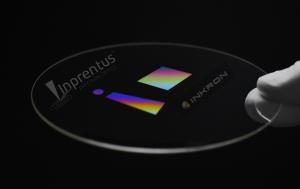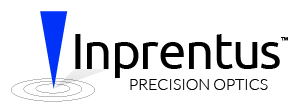Dr. Peter Abbamonte invited to share the story of Inprentus and their unique blazed, mechanically-ruled grating couplers and waveguides for Augmented Reality
With knowledge highlighted in the Fireside Chat, AR waveguide designers can explore blazed gratings as the more effective way of achieving the elusive optical performance needed for smart displays”
CHAMPAIGN, IL, UNITED STATES, January 24, 2025 /EINPresswire.com/ -- SPIE (The International Society for Optics and Photonics) has released the November episode of their monthly Fireside Chat, hosted by Bernard Kress, with Inprentus’ Founder and Chief Science Officer, Peter Abbamonte. Dr Abbamonte was invited by SPIE to share the story of Inprentus and their unique product offering of blazed, mechanically-ruled grating couplers and waveguides for the Augmented Reality (AR) market. — Subha Kumar, Chief Operating Officer of Inprentus
During the chat, Kress discussed some of the key problems and current issues with AR optics. Currently in-use birdbath combiners provide a great image but with an obstructed view and are too thick. Alternatively, waveguides provide the possibility of a higher image transmission and exit pupil expansion, providing a large eye box with lower weight and smaller form factor; however, the persistent problem of eye glow has been very elusive for waveguides in this market. Kress discussed the waveguide structures of binary vs slanted vs blazed and stated that blazed waveguides are superior to the other structures because of the use of one structure to process all colors. In addition, highly custom nanostructures from blazed gratings allow for varying shapes to increase efficiency and uniformity over a larger field of view. However, they have remained challenging to manufacture for the industry.
Kress then introduced Dr. Peter Abbamonte, who gave a history of Inprentus and of the methods by which diffraction gratings were historically made - via either Mechanical Ruling or Interference Lithography. Current waveguides are created using E-beam lithography or DUV lithography, which are not traditional ways to make gratings and are not optimized to create a quality optic.
Abbamonte explained that the AR market approached Inprentus for their unique technology for creating surface relief gratings / waveguides for AR. Inprentus’ mechanical ruling methods allow the manufacture of blazed gratings that are scriptable and flexible, have excellent pitch uniformity, and low stray light. Additionally, the blazed groove shapes can be made with a wide range of angles and are modulation friendly. Abbamonte added that AR is a prototypical application for blazed gratings because they are highly efficient, highly tunable, and are easy to replicate via nanoimprint lithography (NIL). Inprentus’ gratings in particular are suited to waveguides because there are no write field limitations, and the manufacturing process is substrate agnostic. Abbamonte went on to show the capabilities of Inprentus’ AR design prototype blazed waveguides with high throughput, as well as waveguides made from Inprentus masters using NIL replication partner companies like Inkron.
In addition to AR, Inprentus gratings are optimal for research, Lidar / echelles, DUV, and EUV semiconductor equipment. With 12 years of design and production experience, Inprentus also offers design and metrology services.
In conclusion, Kress posited that blazed structures are the best option for single plate waveguides (all 3 colors on one plate) because they have the widest spectral bandwidth of any structure, are substrate agnostic, and are easier to replicate than slanted gratings. Kress added that an interesting feature of blazed gratings is that they are notoriously fault tolerant = i.e. the shapes do not have to be perfect to work well, and imperfect structures can have better results optically than theoretically perfect structures. He noted that, interestingly, some current AR optical engineers think of waveguides as more of a photonic chip rather than as an optical waveguide.
"Experts have been aware of the advantages of blazed structures as couplers for AR waveguides, but the lack of manufacturing options meant that industry designers have increasingly used blazed substitute structures, like slanted gratings, for pupil expansion and outcoupling. As Peter points out, Inprentus’ mechanical ruling technique is the original and simple way to manufacture blazed structures. With the knowledge highlighted in the Fireside Chat, AR waveguide designers can now explore blazed gratings as the more effective way of achieving the elusive optical performance needed for smart displays" says Subha Kumar, COO of Inprentus.
SPIE’s Fireside Chats are hosted by Bernard Kress and are a venue to welcome XR industry leaders to explore aspects of XR hardware, innovation, and development. Webinars include market updates, guest presentations, and Q&A time. You can watch the full fireside chat here: https://spie.org/conferences-and-exhibitions/ar-vr-mr/program/monthly-webinars
Inprentus designs, manufactures, and sells X-ray and EUV diffraction gratings for a variety of scientific and commercial applications by companies, academic institutions, and government laboratories around the world. Inprentus was founded in June 2012 to commercialize an innovative, nano-scale lithography technology using mechanical deformation of metallic surfaces. Proudly located in the Midwest of the USA, the Inprentus team truly exemplifies an unwavering belief in the power of can-do creativity, perseverance, and excellence.
Cynthia Ottemann
Inprentus, Inc
+1 217-239-9862
email us here
Legal Disclaimer:
EIN Presswire provides this news content "as is" without warranty of any kind. We do not accept any responsibility or liability for the accuracy, content, images, videos, licenses, completeness, legality, or reliability of the information contained in this article. If you have any complaints or copyright issues related to this article, kindly contact the author above.



